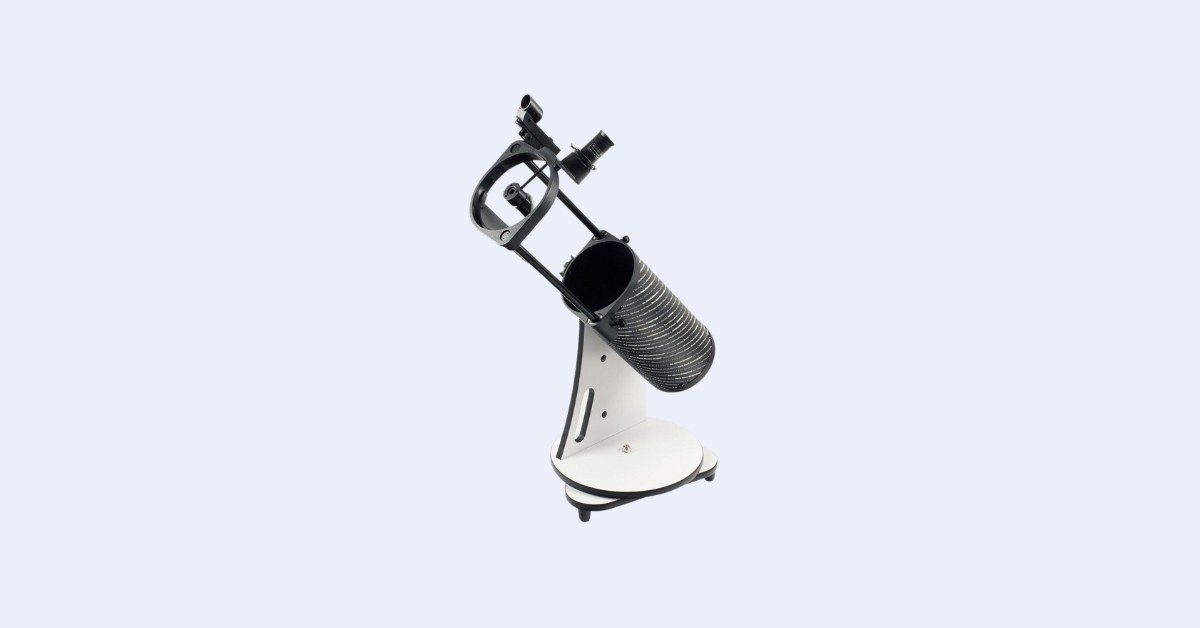The Heritage 130P, or AWB OneSky in the US, is a 130mm (5.1″) f/5 with a focal length of 650mm, just like the Celestron StarSense 130mm tabletop Dobsonian and many tripod-mounted 130mm f/5 scopes like the Celestron Astro Fi 130 and Celestron NexStar 130SLT. But, unlike those telescopes, the 130P has a collapsable tube.
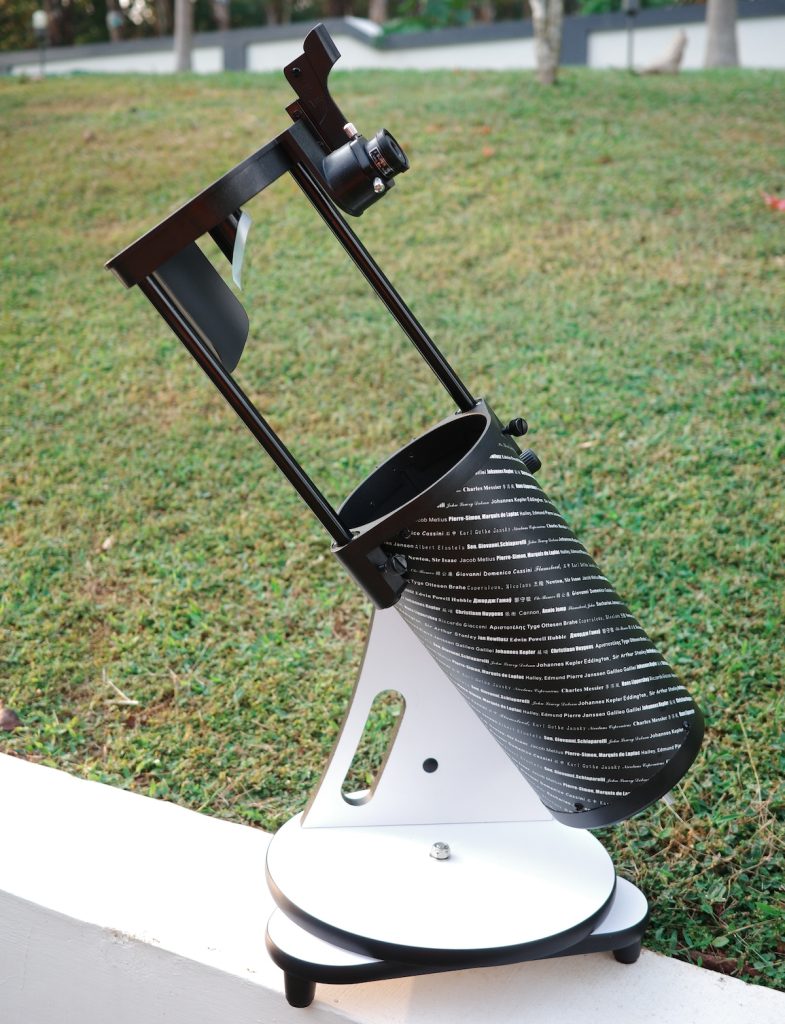
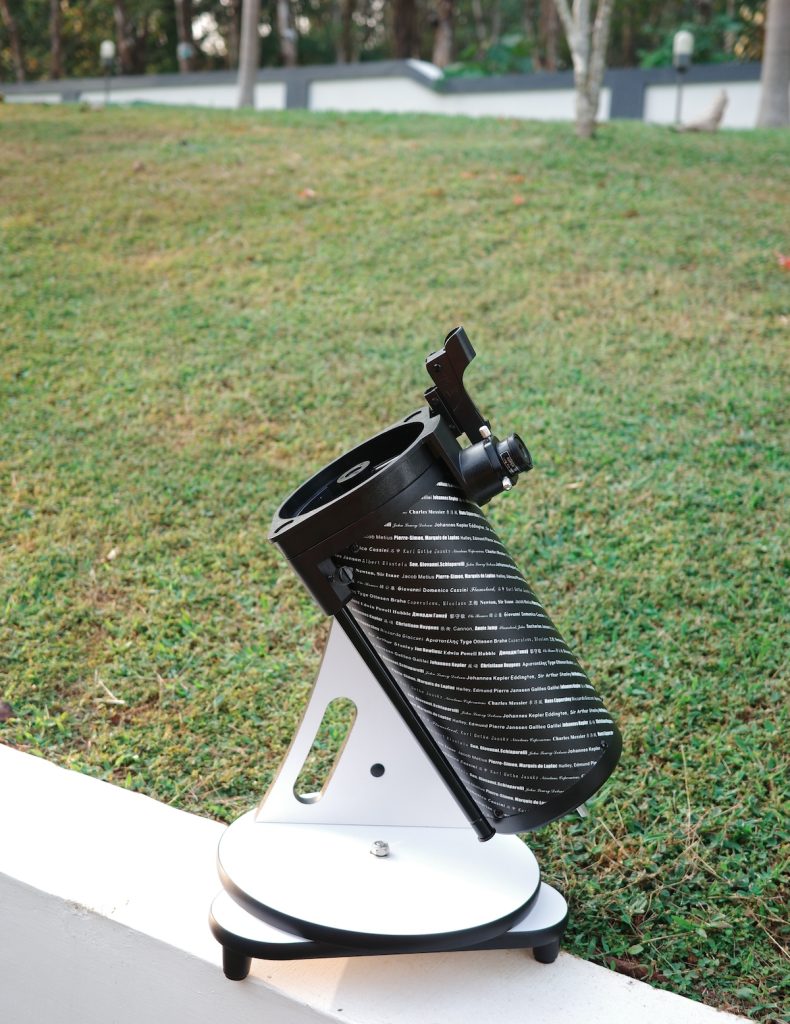
As seen above, the entire front section has been replaced with a pair of struts like those on Sky-Watcher’s larger collapsable/FlexTube Dobsonians, and the focuser, finderscope, and secondary mirror are held in a simple circular frame.
At this point, I guess you might be wondering why more scopes aren’t sold in this configuration. The answer is that it does inevitably come with compromises that not all users are willing to contend with.
The first, obviously, is the large amount of stray light that can get into the tube.
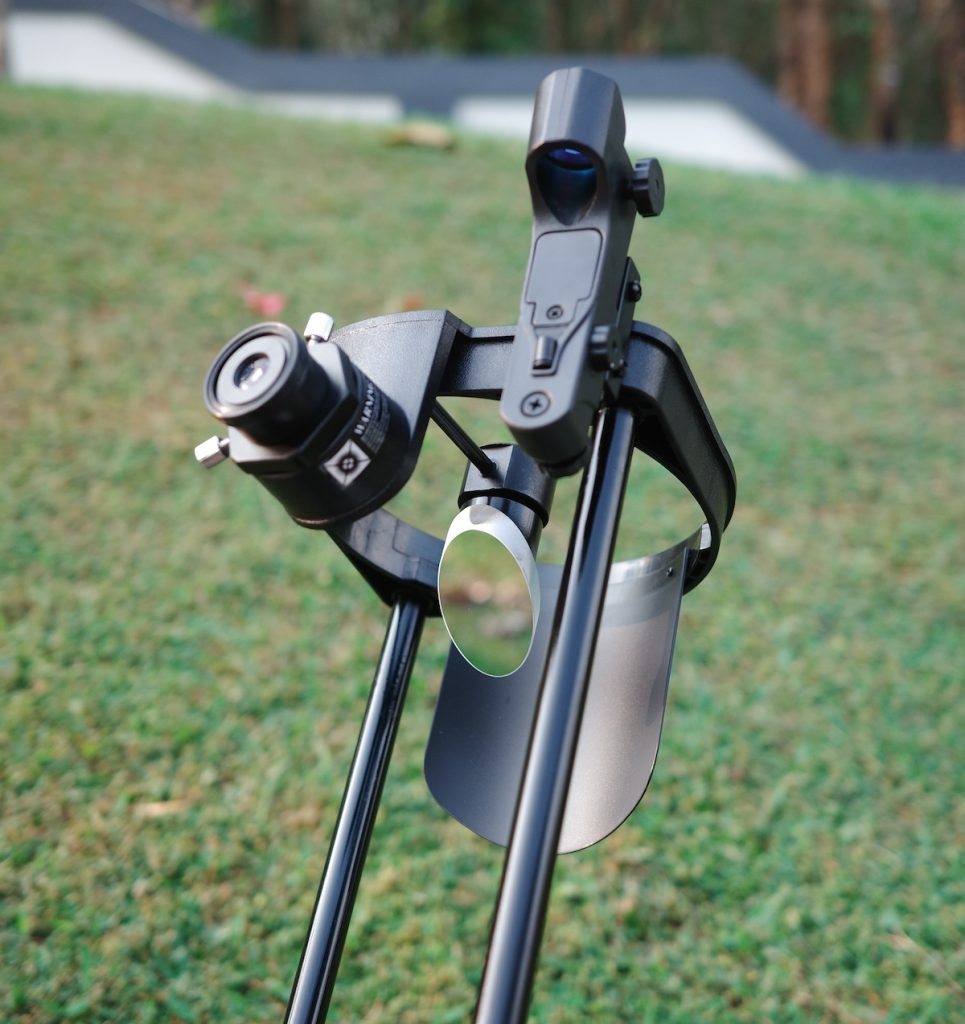
The scope does have a baffle directly across from the focuser (see Image 1 above) that prevents light from shining directly into the focuser. But light pollution, moonlight, and even the glare from bright stars can still get in around this baffle—or bounce off it, since it is rather shiny plastic. You can solve this with a DIY shroud, but this is, of course, an additional hassle and expense, and it’s still not quite as good as a closed tube.
Second, the scope does tend to lose collimation a little more often.
This, to me, is almost a nonissue. The tube is so short that I can make adjustments while looking through the eyepiece at a bright star or using a collimation tool. It only takes a minute or so to do it anyway.
Lastly, the biggest (and seemingly least discussed) issue I’ve noticed with the 130P, and a compromise due to the collapsable tube, is the scope’s helical focuser.
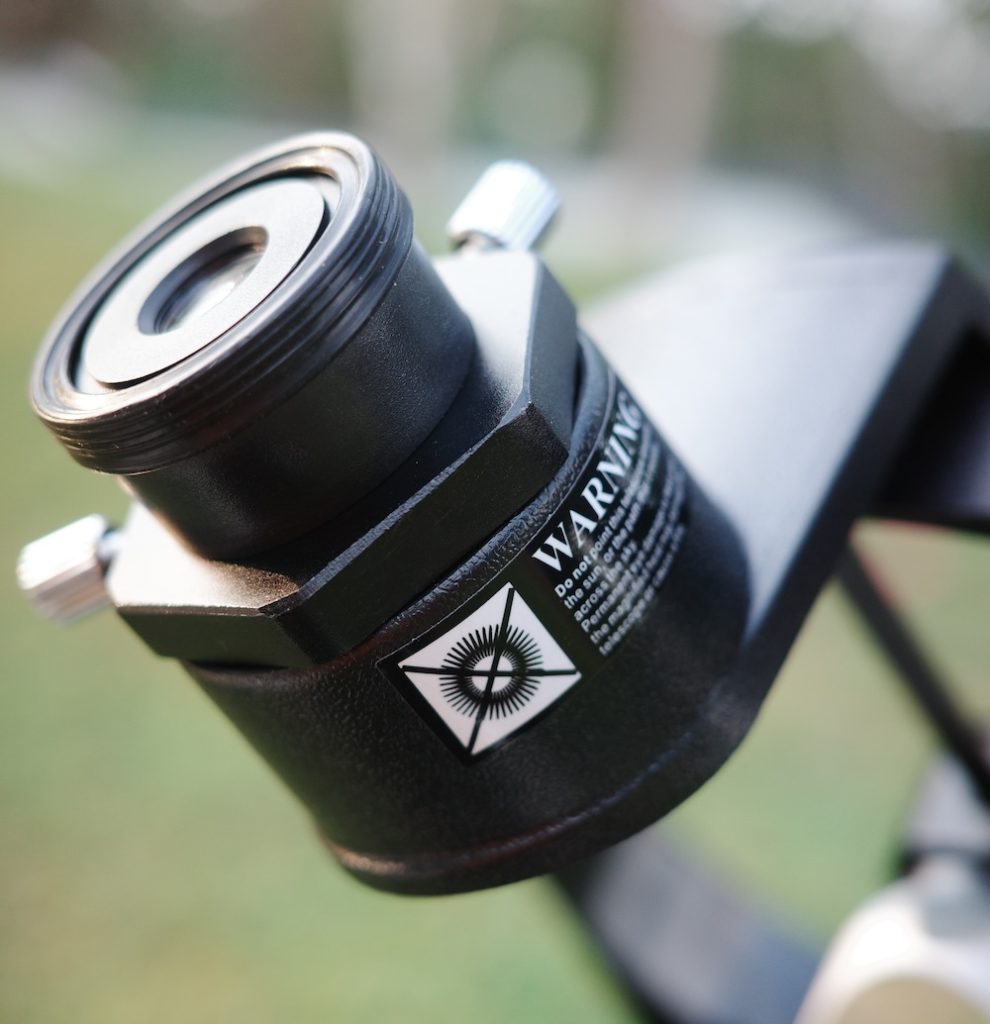
Rather than using a gear and teeth (as with a rack and pinion design) or rollers (as in a Crayford), the helical focuser is simply a threaded drawtube that slides in and out of a threaded receptacle. This works okay, but it can be confusing if you’ve been using another telescope. It also cannot hold heavy eyepieces or cameras (it also spins the camera around as I focus, which is infuriating).
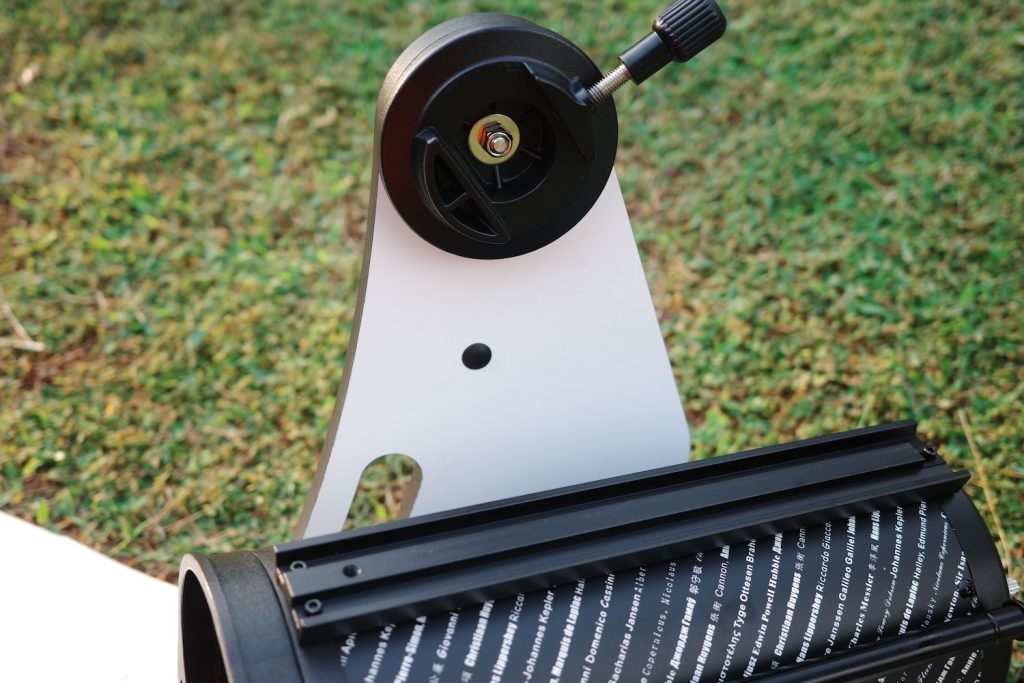
The tube also has a Vixen-style dovetail, which allows it to be slid back and forth on its mount to balance and be compacted for storage. You could use this dovetail to put the scope on another mount or tripod, but keep in mind that the finderscope will be in a rather inconvenient location if you mount the scope on an equatorial mount or a standard photo tripod.
Reviewing the Accessories
The Heritage comes with a red dot finder and two eyepieces: 25mm and 10mm “Super” eyepieces, yielding 26x and 65x, respectively.
To me, the “Super” design seems to just be a modified variant of the Kellner eyepiece configuration. It’s a little suboptimal for an f/5 telescope, but a decent performer nonetheless.
The two eyepieces have mostly plastic bodies but are built to a fairly decent standard of quality, and I have no complaints about them, especially given the price of the telescope they are included with.
The scope’s included red-dot finder works very well, especially given that this telescope is a wide-field instrument, so precise aiming isn’t really required anyway.
The “tabletop Dobsonian” Mount
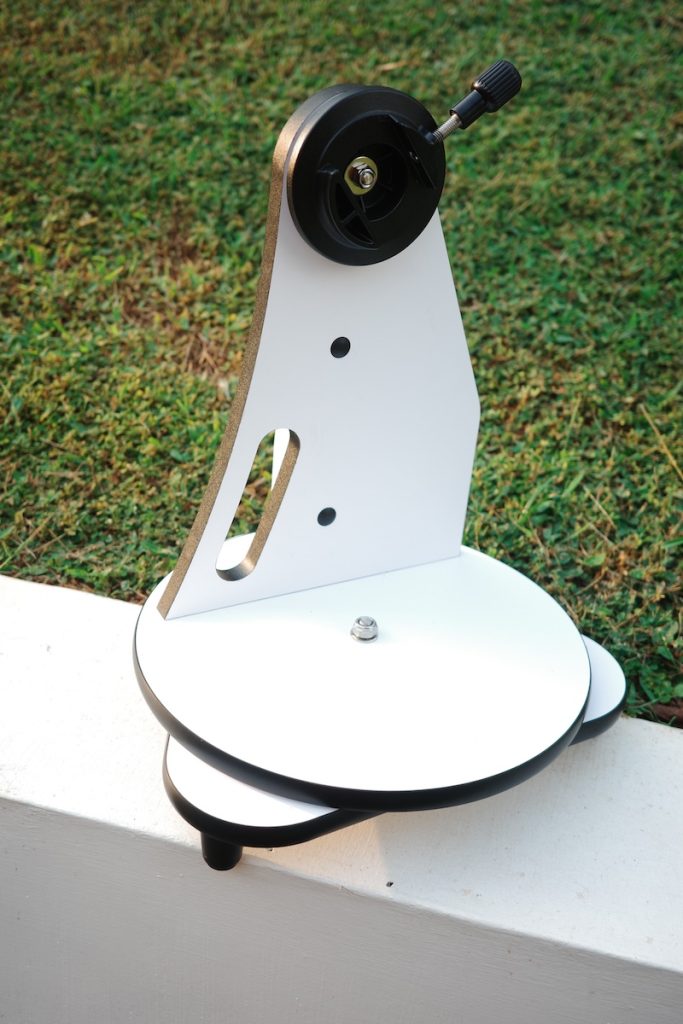
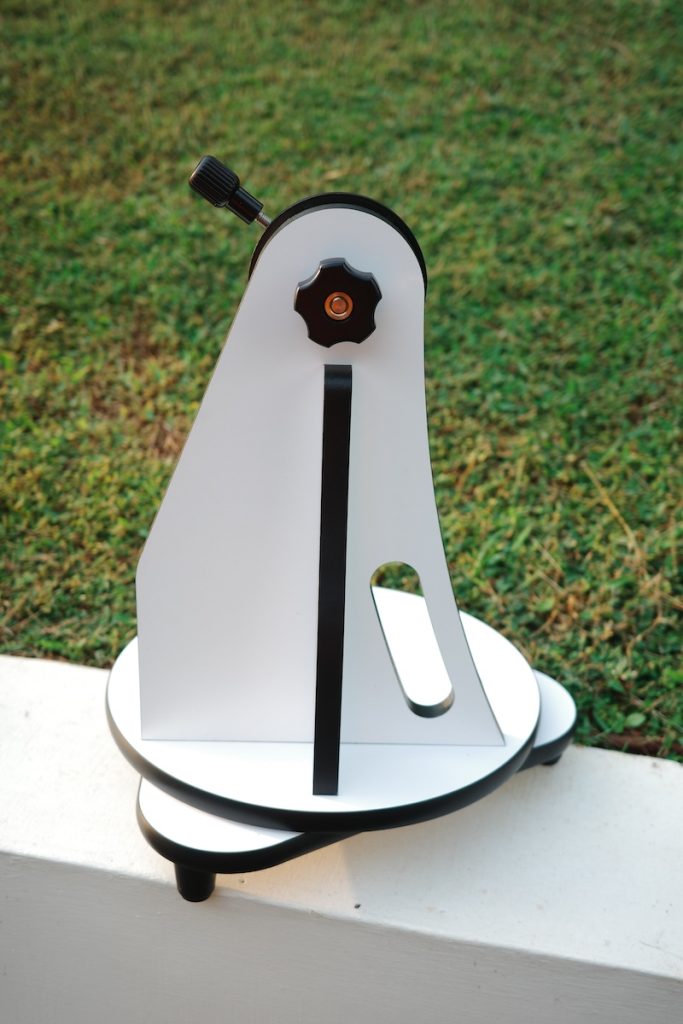
The Skywatcher Heritage 130P’s mount is often referred to as a “tabletop Dobsonian.”
Technically, it is not a Dobsonian, as the altitude axis only uses one bearing, which has no reliance on gravity. It simply uses a bolt, a knob, some standard and lock washers, and a felt pad.
Other than the fact that the balance can be a little sensitive and that the altitude knob will sometimes get “stuck” and loosen or tighten itself as you move the telescope, I have no real complaints about this system.
The azimuth bearing is of the standard Dobsonian design: Teflon on laminate.
Obviously, given that this is a tabletop telescope, you’re probably wondering what I recommend putting it on.
My personal preference would be a 3-legged stool. They’re cheap, they’re sturdy, and they look classy. A four-legged stool works too, but it’s more likely to wobble. In a pinch, the telescope will work on the hood of most cars because the rubber feet allow it to rest on a slight incline.
You could also make your own stand for the telescope that could hold an accessory tray or storage container.
Should I buy a used Skywatcher Heritage 130P?
If you can find one of these telescopes used, I’d absolutely recommend buying it. Keep in mind that you should always check for coating deterioration with a used Newtonian, especially one with an open tube like the Sky-Watcher Heritage 130P.
Alternative Recommendations
The Heritage 130P is our top pick in its price range, but if you must choose something else or have a larger budget, here are our recommendations:
Under £250
- The Zhumell Z114 and Orion StarBlast 4.5 Astro don’t have quite as much aperture as the Heritage 130P, but both provide a significantly wider field of view and have solid instead of collapsable tubes if the collapsable nature of the 130P concerns you.
- The Zhumell Z130 offers the same aperture, performance, and more or less the same accessories as the Heritage 130P, but it is a bit bulky, collimation requires a screwdriver, and availability and pricing are spotty nowadays.
£250-£325
- The Sky-Watcher Heritage 150P is essentially a scaled-up 130P, and differs little apart from the performance boost from its extra inch of aperture. A computerised version of the 150P is available as the Virtuoso 150P GTi.
- The Bresser Messier 6” f/8 Planetary Dobsonian has a narrower field than the 150P, thanks to its f/8 focal ratio, though this is somewhat compensated for by its hefty 2” Crayford focuser. The main advantage of the XT6 is that it stands flat on the ground without additional support or elevation, though it’s significantly less compact, lightweight, or portable than a tabletop instrument of similar aperture like the Sky-Watcher Heritage telescopes. Sky-Watcher’s own 6” Classic also works pretty well and shares the XT6’s basic design and features, but has inferior bearings and a mediocre focuser.
Aftermarket Accessory Recommendations
In addition to finding a suitable stand, stool, or table and constructing a homemade shroud to enclose the tube, there are several affordable and extremely beneficial accessories worth acquiring for the Heritage 130P to fully optimise its performance.
One such essential accessory is a 6mm redline/goldline eyepiece, which provides 108x magnification with the 130P. This enables you to observe significantly more detail on the Moon and planets compared to the mere 65x magnification offered by the included 10mm eyepiece. By utilising a Barlow lens, you can further increase the magnification to 216x, which is close to the maximum achievable. Another valuable, if not entirely necessary, addition is a 9mm redline/goldline eyepiece (72x magnification) to replace the provided 10mm eyepiece. The redline/goldline eyepiece boasts a considerably wider apparent field of view, approximately 70 degrees, in contrast to the 55-degree field of the Super eyepieces. Furthermore, it offers greater eye relief than the 10mm Super eyepiece, resulting in a more comfortable viewing experience and enhanced sharpness towards the edges of the field of view.
Additionally, a narrowband Ultra High Contrast (UHC)/OIII nebula filter can significantly enhance your views of nebulae, such as the Orion Nebula, when using the Heritage 130P or any other telescope. This filter also makes it easier to locate planetary nebulae by diminishing the brightness of surrounding stars and darkening the background sky, making these “faint fuzzies” more clearly stand out at low magnifications. Moreover, it offers enough contrast improvement to render you able to see previously invisible targets like the Veil Nebula supernova remnant, which is visible using this telescope with a filter under dark skies.
What can you see with the Skywatcher Heritage 130P?
The Heritage 130P’s 5.1” aperture is enough to show a lot of the brighter deep-sky objects, such as the Andromeda Galaxy, Orion Nebula, Ring Nebula, Dumbbell Nebula, and various globular clusters. The scope’s wide field of view also makes it great at showing open clusters such as M11 and M35, and asterisms like the Coathanger.
The scope is also really great for solar system objects. The Moon shows details as small as a couple miles. Venus and Mercury will reveal their phases, while Mars’ ice caps and a few dark regions will be visible. On a steady night, Jupiter and Saturn’s moons, cloud bands, and, of course, the Great Red Spot and rings are visible, and you may be able to catch a glimpse of the Cassini Division within Saturn’s rings. Uranus and Neptune are, of course, merely teal and azure dots with no detail whatsoever – you may struggle to differentiate Neptune from a star at all due to its tiny angular size!

